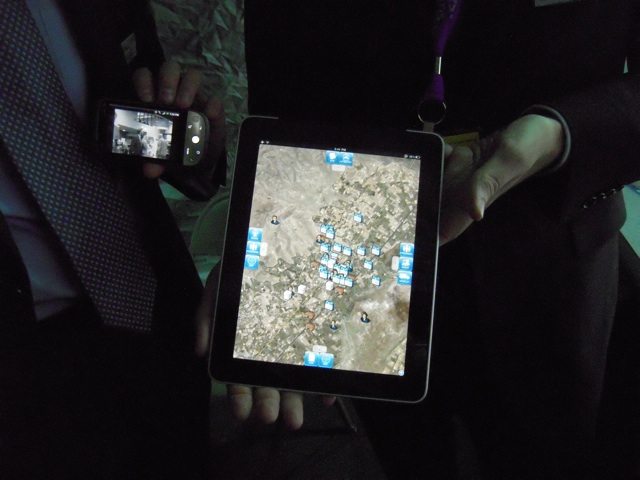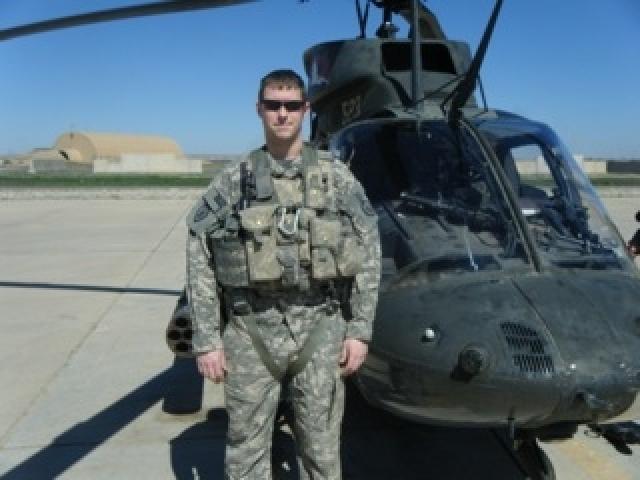Overwatch, an operating unit of Textron Systems, announced today that its SoldierEyes smartphone-enabled analysis and battle tracking system will be a part of various upcoming U.S. Army field tests of smartphones, network equipment and applications. These tests are in support of the Army’s Brigade Modernization initiatives, following Overwatch’s more than eighteen months of support of the U.S. Army’s 2nd Brigade, 1st Armor Division of the Brigade Modernization Command (BMC). A goal of the BCM is to evolve the SoldierEyes system to address the situational awareness needs of soldiers in full-spectrum operations.
“SoldierEyes is an outstanding example of the next generation of tools available to the individual warfighter,” said Mike McCarthy, director of Operations, Brigade Modernization Command, TRADOC, U.S. Army. “The SoldierEyes technology has produced very relevant and open, smartphone-enabled services and applications that may be easily tailored to meet the needs of the Army.”
SoldierEyes is fully operable within government fielded communications environments such as 3G/4G cellular and WiFi. In remote areas of the globe, where reliable connections are non-existent, SoldierEyes devices and systems are able to connect via the new FASTCOM technology co-developed by Overwatch and Textron Systems’ AAI Unmanned Aircraft Systems division in partnership with ViaSat Inc. FASTCOM is a mobile, secure battlefield cellular network that can be hosted on manned and unmanned aircraft, aerostats, masts or ground vehicles. Leveraging FASTCOM, SoldierEyes users are enabled with secure, mobile network connectivity even in the most austere tactical environments.
“The next generation of tools that SoldierEyes provides will serve to heighten warfighters’ ability to gain and maintain situational awareness throughout all phases of a combat mission. It is a system that tracks across all six warfighting functions: movement and maneuver, fires, intelligence, sustainment, command and control, and protection,” added Col. Marisa Tanner, division chief, Future Force Integration Directorate, TRADOC, U.S. Army.
The benefits of SoldierEyes are two-fold. First, the system provides soldiers with fused information that is populated to form a critical and more relevant common operation picture. This provides the soldier at the tactical edge greatly enhanced situational awareness and situational understanding whenever needed and wherever they are located. Through the integration of mobile technology and application services, SoldierEyes delivers real-time mission centric situational awareness to the warfighter. Viewing each warfighter as a sensor, SoldierEyes provides handheld capabilities for collecting, reporting and communicating mission critical geo-referenced information (video, reports, photos and more) between the soldier and existing command, control, communications, computers, and intelligence, surveillance and reconnaissance (C4ISR) systems.
Secondly, the SoldierEyes system provides an open architecture environment that may be rapidly and continuously updated and improved through third party application development and deployment. The advantage of this system is that it will enable the Army to maximize the reuse of basic services and programs of record while leveraging the power of a large, certified third party development community to rapidly and efficiently address evolving mission needs. This approach provides existing government systems the benefit of fielding new operational applications, access to richer information, and a pathway to a relevant and timely common operating picture from the soldier to every echelon above.
SoldierEyes uses cloud architecture which is designed to operate on existing Government servers and to support any Internet Protocol (IP) enabled client, such as smartphones, tablets and personal computers. This design flexibility allows SoldierEyes to provide utility irrespective of the communications architecture, security protocols, client platforms, as well as various tactics, techniques and procedures (TTPs) employed by the U.S. Army.
“The SoldierEyes Application Cloud manages the movement of information between the soldier, analysis applications and large Army databases. It fully supports a collaborative approach with its open Application Protocol Interface, or API, and available services, such as map servers, standard symbology database and more,” said Overwatch Senior Program Manager Evan Corwin. “To demonstrate the open architecture, the SoldierEyes API has been shared with various third party developers who have easily merged new and existing data sources, sensors, applications, services and cell phone applications with the system. This unique approach highlights the flexibility and growth potential of the system among third party developers.”
Later this year Overwatch will deploy the SoldierEyes system as a member of the FASTCOM team and participant in Empire Challenge 2011, as well as participate in large scale exercises with the U.S. Army’s full-up Armor Brigade at the White Sands Missile Range. Numerous lab and field capability demonstrations and evaluations of the system are also planned throughout the year.
Overwatch, an operating unit of Textron Systems, is the leading provider of integrated intelligence software solutions and services as well as robust satellite communications systems for today’s U.S. and international defense and intelligence communities. For the past 20 years, Overwatch’s intelligence solutions have supported decision makers, counter-terrorism analysts, warfighters and first responders by providing proven tools that simplify the integration, analysis and exploitation of intelligence in order to present a complete operational picture and accelerate the time-to-decision.











